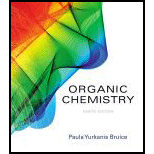
(a)
Interpretation:
The product of the given reaction is has be given.
Concept Introduction:
(b)
Interpretation:
The product of the given reaction is has be given.
Concept Introduction:
Pyridine is more reactive than benzene towards nucleophilic aromatic substitution reactions. Nucleophile adds to the ring carbon attached to the leaving group. Then, the leaving group is eliminated. Substitution takes place at C-2 or C-4 because it leads to the most stable intermediate.
(c)
Interpretation:
The product of the given reaction is has be given.
Concept Introduction:
(d)
Interpretation:
The product of the given reaction is has be given.
Concept Introduction:
Aromatic five-membered heterocyclic compounds undergo electrophilic aromatic substitution reactions preferentially at 2-position. The intermediate obtained by adding a substituent to this position is more stable than the intermediate obtained by adding a substituent to C-3 position.
(e)
Interpretation:
The product of the given reaction is has be given.
Concept Introduction:
Pyridine is more reactive than benzene towards nucleophilic aromatic substitution reactions. Nucleophile adds to the ring carbon attached to the leaving group. Then, the leaving group is eliminated. Substitution takes place at C-2 or C-4 because it leads to the most stable intermediate.
(f)
Interpretation:
The product of the given reaction is has be given.
Concept Introduction:
Alkyl halide reacts with amine to form alkyl-substituted product. The reaction mechanism is nucleophilic aliphatic substitution. Amines are generally nucleophilic in nature. Therefore, the reaction easily occurs in mild conditions.
(g)
Interpretation:
The product of the given reaction is has be given.
Concept Introduction:
Aromatic five-membered heterocyclic compounds undergo electrophilic aromatic substitution reactions preferentially at 2-position. The intermediate obtained by adding a substituent to this position is more stable than the intermediate obtained by adding a substituent to C-3 position.
(h)
Interpretation:
The product of the given reaction is has be given.
Concept Introduction:
Pyridine is more reactive than benzene towards nucleophilic aromatic substitution reactions. Nucleophile adds to the ring carbon attached to the leaving group. Then, the leaving group is eliminated. Substitution takes place at C-2 or C-4 because it leads to the most stable intermediate.
(i)
Interpretation:
The product of the given reaction is has be given.
Concept Introduction:
Aromatic five-membered heterocyclic compounds undergo electrophilic aromatic substitution reactions preferentially at 2-position. The intermediate obtained by adding a substituent to this position is more stable than the intermediate obtained by adding a substituent to C-3 position.
Want to see the full answer?
Check out a sample textbook solution
Chapter 19 Solutions
Pearson eText Organic Chemistry -- Instant Access (Pearson+)
- Identify and provide a concise explanation of a specific analytical instrument capable of detecting and quantifying trace compounds in food samples. Emphasise the instrumental capabilities relevant to trace compound analysis in the nominated food. Include the specific application name (eg: identification and quantification of mercury in salmon), outline a brief description of sample preparation procedures, and provide a summary of the obtained results from the analytical process.arrow_forwardIdentify and provide an explanation of what 'Seperation Science' is. Also describe its importance with the respect to the chemical analysis of food. Provide specific examples.arrow_forward5. Propose a Synthesis for the molecule below. You may use any starting materials containing 6 carbons or less (reagents that aren't incorporated into the final molecule such as PhзP do not count towards this total, and the starting material can have whatever non-carbon functional groups you want), and any of the reactions you have learned so far in organic chemistry I, II, and III. Your final answer should show each step separately, with intermediates and conditions clearly drawn. H3C CH3arrow_forward
- State the name and condensed formula of isooxazole obtained by reacting acetylacetone and hydroxylamine.arrow_forwardState the name and condensed formula of the isothiazole obtained by reacting acetylacetone and thiosemicarbazide.arrow_forwardProvide the semi-developed formula of isooxazole obtained by reacting acetylacetone and hydroxylamine.arrow_forward
- Given a 1,3-dicarbonyl compound (R1-CO-CH2-CO-R2), indicate the formula of the compound obtaineda) if I add hydroxylamine (NH2OH) to give an isooxazole.b) if I add thiosemicarbazide (NH2-CO-NH-NH2) to give an isothiazole.arrow_forwardAn orange laser has a wavelength of 610 nm. What is the energy of this light?arrow_forwardThe molar absorptivity of a protein in water at 280 nm can be estimated within ~5-10% from its content of the amino acids tyrosine and tryptophan and from the number of disulfide linkages (R-S-S-R) between cysteine residues: Ε280 nm (M-1 cm-1) ≈ 5500 nTrp + 1490 nTyr + 125 nS-S where nTrp is the number of tryptophans, nTyr is the number of tyrosines, and nS-S is the number of disulfide linkages. The protein human serum transferrin has 678 amino acids including 8 tryptophans, 26 tyrosines, and 19 disulfide linkages. The molecular mass of the most dominant for is 79550. Predict the molar absorptivity of transferrin. Predict the absorbance of a solution that’s 1.000 g/L transferrin in a 1.000-cm-pathlength cuvet. Estimate the g/L of a transferrin solution with an absorbance of 1.50 at 280 nm.arrow_forward
- In GC, what order will the following molecules elute from the column? CH3OCH3, CH3CH2OH, C3H8, C4H10arrow_forwardBeer’s Law is A = εbc, where A is absorbance, ε is the molar absorptivity (which is specific to the compound and wavelength in the measurement), and c is concentration. The absorbance of a 2.31 × 10-5 M solution of a compound is 0.822 at a wavelength of 266 nm in a 1.00-cm cell. Calculate the molar absorptivity at 266 nm.arrow_forwardHow to calculate % of unknown solution using line of best fit y=0.1227x + 0.0292 (y=2.244)arrow_forward
- Chemistry: Matter and ChangeChemistryISBN:9780078746376Author:Dinah Zike, Laurel Dingrando, Nicholas Hainen, Cheryl WistromPublisher:Glencoe/McGraw-Hill School Pub Co
 EBK A SMALL SCALE APPROACH TO ORGANIC LChemistryISBN:9781305446021Author:LampmanPublisher:CENGAGE LEARNING - CONSIGNMENT
EBK A SMALL SCALE APPROACH TO ORGANIC LChemistryISBN:9781305446021Author:LampmanPublisher:CENGAGE LEARNING - CONSIGNMENT Living By Chemistry: First Edition TextbookChemistryISBN:9781559539418Author:Angelica StacyPublisher:MAC HIGHER
Living By Chemistry: First Edition TextbookChemistryISBN:9781559539418Author:Angelica StacyPublisher:MAC HIGHER


